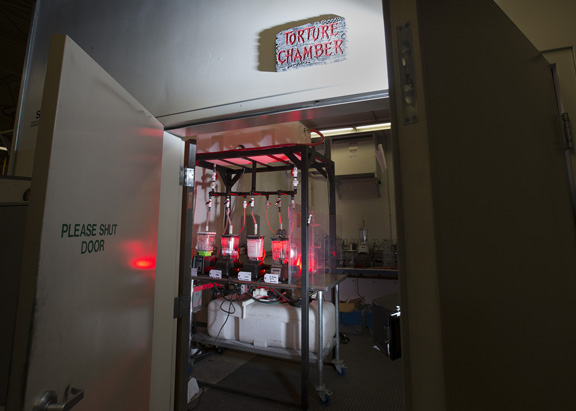July 21, 2014
If you’re a blender, you’d never want to see the inside of the testing lab in Blendtec‘s headquarter in Orem, Utah. This small room is the equivalent of The Tower of London for blenders. The products that go in don’t usually come out in one piece.
“We call [the test facility] ‘the Torture Chamber’ because we line up all of our blenders and brutally test them until they die,” said Reid Stout, a research and development engineer with Blendtec.
If you’re an automaker, conducting a destructive test on your product means crashing a fully built car rigged with dummies into a wall—a costly experiment you can’t undertake willy-nilly. If you’re an aerospace manufacturer, crash-testing a plane for every new model is certainly out of the question. (Boeing conducted one such test in 2012 with a remote-controlled 727. The rare incident was captured in a Discovery Channel documentary.)
To bypass these costly tests involving massive products (not to mention the cleanup required afterward), manufacturers now rely mostly on digital simulation and software-driven analysis to perform tests. But if you make blenders like Blendtec does, you can afford to sacrifice a few blenders every month for the good of your customers.
Joey Jacobsen, the testing engineer at Blendtec, said, “With digital simulation, you’re looking at a very specific, narrowly defined scenario—like the deflection in a specific beam. You have to make assumptions, idealize the conditions, and there may be certain concerns you dismiss because you feel they’re negligible. But when you build and test a real product, you get everything, both intended and unintended effects.”
Blendtec uses SolidWorks CAD modeling program’s simulation functions along with some basic CFD tools for digital simulation, according to Jacobsen. But the nature of the products makes physical tests a lot easier to set up than computer-based simulation. “When a blender runs, the objects inside start off as solids, then transform into liquid. This is very difficult to model, a very complex CFD problem,” explained Jacobsen—“perhaps too complex, when you can just build the product and test it.”
The facility is set up to perform a series of rigorous tests on the blenders automatically, blending for a period of time, then resting for short period, then blending again. During these blend-and-rest cycles, engineers monitor temperature, number of cycles it takes to break a product, voltage, and even sound. “The sound a blender makes, for example, could be an indicator of impending failure,” explained Jacobsen.
When Blendtec came to the realization that its Torture Chamber was due for an upgrade, they began seeking fresh new ideas for improvement. They didn’t have to look far for people with creative, ingenious ideas on the art of destruction. The Capstone program ran by the company involves working with students from local universities and schools. So the thrilling assignment to revamp the Torture Chamber went to a group of lucky undergraduates from nearby Brigham Young University (BYU).
One of the challenges in the previous incarnation of the test facility was to keep the lids fully secured while the automatic tests were in progress. “We had even used fasteners to keep the lids closed,” recalled Jacobsen.
In an article about the students’ contribution to the new Torture Chamber, BYU wrote, “Originally test preparation was a long, painful process that could take up to 30 minutes. The team would use silicone or even screws to secure the lids. Now, the lids can just snap on and off, reducing test preparation time to almost five minutes.”
Jacobsen added, “The students also came up with easier ways to keep the test environment clean and sanitized.”
The Torture Chamber and the insights it yield serve as a reminder that, while digital simulation has become the norm in modern manufacturing, physical testing remains the gold standard for discovering design flaws and weaknesses.
Blendtec test facility is also where engineers prepare for the popular show “Will It Blend?” presented by Blendtec. In the latest episode, the show presenter tried to blend a series of iPhones in the blender. The mesmerizing act of destruction is captured in slow-motion in the footage below:
Subscribe to our FREE magazine, FREE email newsletters or both!
About the Author
Kenneth Wong is Digital Engineering’s resident blogger and senior editor. Email him at [email protected] or share your thoughts on this article at digitaleng.news/facebook.
Follow DE






